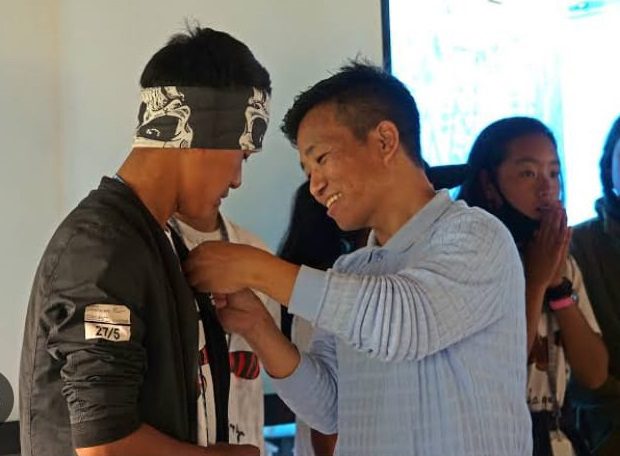Once a hub of timber operations, the Singchung forests, located in the West Kameng district of Arunachal Pradesh, are now a shining example of how involving the community in forest conservation can bear good fruits.
The Singchung Sub-Division is predominantly inhabited by the Buguns, a Scheduled Tribe in Arunachal Pradesh. In close consultation with the Singchung Village Council, the Environment, Forest and Climate Change Department of the state, took a progressive step for forest conservation by declaring 17 sq km of the Singchung Community Forests as a Community Reserve in the year 2017, under section 36 C of Wildlife (Protection) Act, 1972. Since then, the Buguns have been actively engaged in the forests protection and conservation.
The conservation programme focuses especially on Bugun Liocichla, a passerine bird discovered in the forests near Singchung village. This discovery catalysed conservation activities in the area by the local community.
Indian Masterminds spoke to the Conservator of Forests (Headquarter) of Arunachal Pradesh, Mr. Millo Tasser, a 2009-batch IFS officer, for more details of the community engagement in the community reserve.

HOME OF BUGUN LIOCICHLA
In Singchung, the region near the Eaglenest Wildlife Sanctuary has a high bird diversity level. In fact, when it comes to birds, the area is a global powerhouse, with rare species like the ward’s trogon and the Blyth’s tragopan. And, the discovery of the Begun liocichla (Liocichla bugunorum) added another feather to its cap.
Listed in Schedule I of the Wildlife (Protection), Act 1972, Bugun liocichla was first sighted by astrophysicist Dr. Ramana Athreya in 1995, who later described the bird as a new species in 2006.
“Only 14 to 20 pairs are believed to exist in the world. The bird is mostly sighted in Singchung Bugun Village Community Reserve near Eaglenest Wildlife Sanctuary in the West Kameng District of Arunachal Pradesh and has been sighted in the Eaglenest Wildlife Sanctuary and outside of it near Shergaon and Bomdila once, but has not been reported from anywhere else in the world so far,” said Mr. Millo Tasser, who was earlier the DFO of Eaglenest Wildlife Sanctuary.
EARNING BY CONSERVING
Bird tourism was introduced for the first time in 2005. Members of the Singchung Village Council, who are part of the Community Reserve Management Committee of the state Forest and Environment department, extend full support to birdwatchers, nature lovers and adventure eco-tourists, while ensuring that there is no damage to the ecosystem. The village council also institutionalised a community-based wildlife tourism programme in the region. In this way, the local people earn additional income while conserving nature.
“People realised the benefits of conservation that culminated in the notification of a 17 sq km Community Reserve in the year 2017. Today, many members of the community are engaged in bird tourism that generates a significant amount of revenue to them,” Mr. Tasser said.

YOUTH PATROL
Also, 12 Bugun youths from the Singchung village patrol the forests daily and stay in the anti-poaching camp at the community reserve’s entry. The youths are trained to handle human-wildlife conflicts and they conduct lessons on nature education for school children and facilitate a host of adventure activities, which generates revenue for the reserve.
RESERVOIR OF BIODIVERSITY
The forests of the Bugun community of Singchung village are an exceptional reservoir of globally important biodiversity, including charismatic animal species like the red panda and golden cat, endangered plant species like the lady-slipper orchid, and some of the most spectacular oak and rhododendron forests in the region. These forests are also home to elephants, Asiatic black bears, gaur and other species. Tourists from all over the world come here to see the liocichla, purple cochoa, honey guide and ward’s trogon.
TURNAROUND FROM A TIMBER HUB
However, the scene was very different till a few years ago. The same forests were once a hub of timber operations. Large-scale logging was rampant. In order to control the timber operations, the local people began hunting for checks and balances. To protect the rich biodiversity and water resources, any form of hunting, tree felling, collection of Non-Timber Forest Produce and entry into the reserve without permission was prohibited by the Singchung village council.
Mr. Tasser said, “Post 1996, after the logging ban order issued by the Supreme Court of India, logging operations in Bugun forests also reduced. That was also the time when the area was getting scientifically explored by researchers. With the discovery of rich biodiversity around Eaglenest Wildlife Sanctuary, local community members were introduced to the benefits of conservation.”
In addition, awareness programmes were started in schools. In the last five years, over 400 students from 12 local schools around Eaglenest Wildlife Sanctuary have participated in the annual residential wildlife week camps run by the Environment and Forests Department with active participation of Singchung Village Council.
These students have learned about the unique flora and fauna of the community reserve, and the urgent need to protect the rare Bugun Liocichla. They are sensitised not to hunt or destroy biodiversity and encourage villagers to do the same. Over 50 teachers from 12 local schools were especially trained to incorporate biodiversity conservation into the school curriculums.

AWARD TO BUGUN COMMUNITY
In 2018, the Singchung Bugun Village Community Reserve was awarded by the National Biodiversity Authority (NBA) for conserving the region’s natural ecosystem in the category of Conservation of Wild Species. A growing list of rediscoveries and range extensions from the Bugun community area includes the Abor Hills agama, the Jerdon’s red-spotted pit viper, and butterflies like Ludlow’s Bhutan glory and Tibetan brimstone.
The forest also has a larger cultural significance as the Bugun tribe considers it a holy mountain. Mr. Tasser explained, “Tribes in Arunachal have been living in harmony with nature since time immemorial. Festivals are observed in honour and reverence of nature for its various tangible and intangible services to mankind. For instance, Pham Kho Sowai festival of Bugun tribe derives its name from ‘Pham’ meaning Mountain and ‘Kho’ meaning river is a celebration of nature for its bountifulness.”
As tourists have started thronging to this region to see its rich biodiversity and cultural uniqueness, colourful tourist camps can be seen now in the areas that used to be once dotted with brown timber logging camps.


































